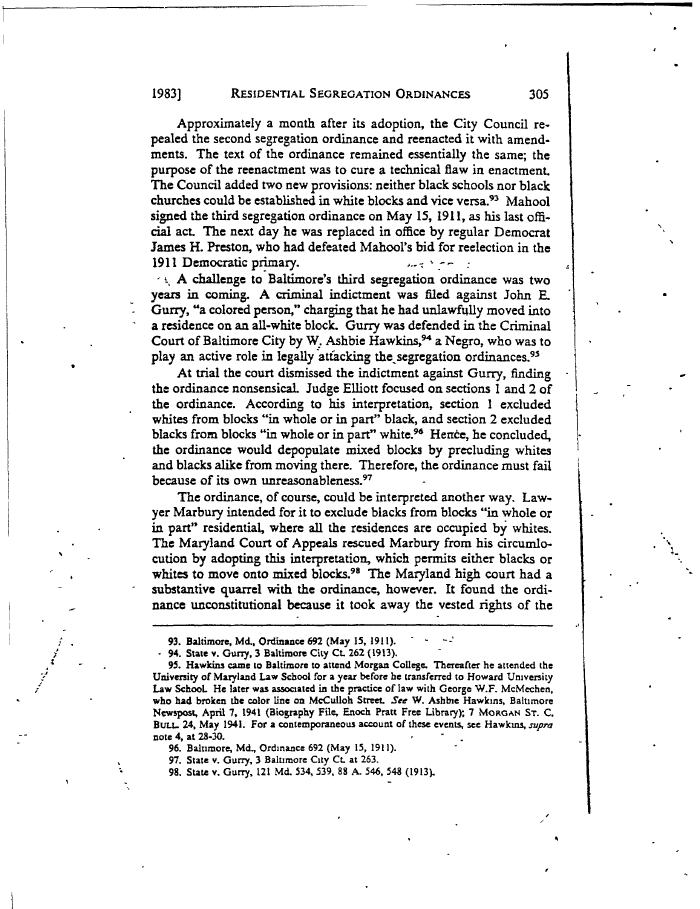 |
||||
|
Garrett Power, Apartheid Baltimore Style: The Residential Segregation Ordinances of 1910-1913, Maryland Law Review, 42 (1983) , Image No: 18 Enlarge and print image (65K) << PREVIOUS NEXT >> |
 |
||||
|
Garrett Power, Apartheid Baltimore Style: The Residential Segregation Ordinances of 1910-1913, Maryland Law Review, 42 (1983) , Image No: 18 Enlarge and print image (65K) << PREVIOUS NEXT >> |
| 1983] RESIDENTIAL SEGREGATION ORDINANCES 305 Approximately a month after its adoption, the City Council re- pealed the second segregation ordinance and reenacted it with amend- ments. The text of the ordinance remained essentially the same; the purpose of the reenactment was to cure a technical flaw in enactment. The Council added two new provisions: neither black schools nor black churches could be established in white blocks and vice versa.93 Mahool signed the third segregation ordinance on May 15, 1911, as his last offi- cial act The next day he was replaced in office by regular Democrat James H. Preston, who had defeated Mahool's bid for reelection in the 1911 Democratic primary A challenge to Baltimore's third segregation ordinance was two years in coming. A criminal indictment was filed against John E. Gurry, "a colored person," charging that he had unlawfully moved into a residence on an all-white block. Gurry was defended in the Criminal Court of Baltimore City by W. Ashbie Hawkins,94 a Negro, who was to play an active role in legally attacking the segregation ordinances.93 At trial the court dismissed the indictment against Gurry, finding the ordinance nonsensical Judge Elliott focused on sections 1 and 2 of the ordinance. According to his interpretation, section 1 excluded whites from blocks "in whole or in part" black, and section 2 excluded blacks from blocks "in whole or in part" white.96 Hence, he concluded, the ordinance would depopulate mixed blocks by precluding whites and blacks alike from moving there. Therefore, the ordinance must fail because of its own unreasonableness.97 The ordinance, of course, could be interpreted another way. Law- yer Marbury intended for it to exclude blacks from blocks "in whole or in part" residential, where all the residences are occupied by whites. The Maryland Court of Appeals rescued Marbury from his circumlo- cution by adopting this interpretation, which permits either blacks or whites to move onto mixed blocks.98 The Maryland high court had a substantive quarrel with the ordinance, however. It found the ordi- nance unconstitutional because it took away the vested rights of the 93. Baltimore, MA, Ordinance 692 (May 15, 1911). ' - --' - 94. State v. Gurry, 3 Baltimore City Ct. 262 (1913). 95. Hawkins came to Baltimore to attend Morgan College. Thereafter he attended the University of Maryland Law School for a year before he transferred to Howard University Law School He later was associated in the practice of law with George W.F. McMechen, who had broken the color line on McCulloh Street. See W. Ashbie Hawkins, Baltimore Newspost, April 7, 1941 (Biography File, Enoch Pratt Free Library); 7 MORGAN ST. C. BULL. 24, May 1941. For a contemporaneous account of these events, see Hawkins, supra note 4, at 23-30. 96. Baltimore, MA, Ordinance 692 (May 15, 1911). 97. State v. Gurry, 3 Baltimore City Ct. at 263. 98. State v. Gurry. 121 Md. 534, 539, 88 A. 546, 548 (1913). |